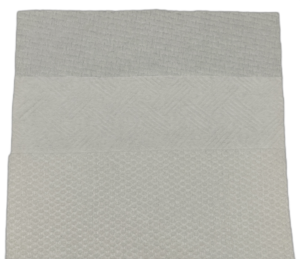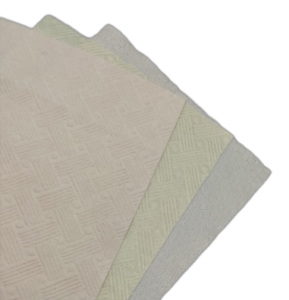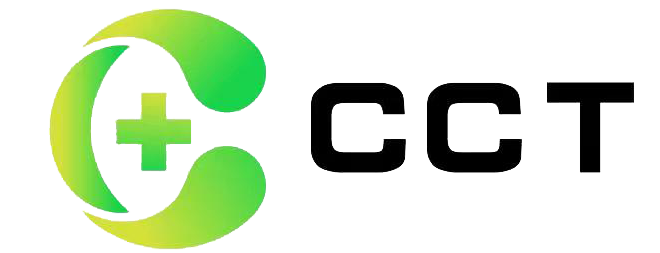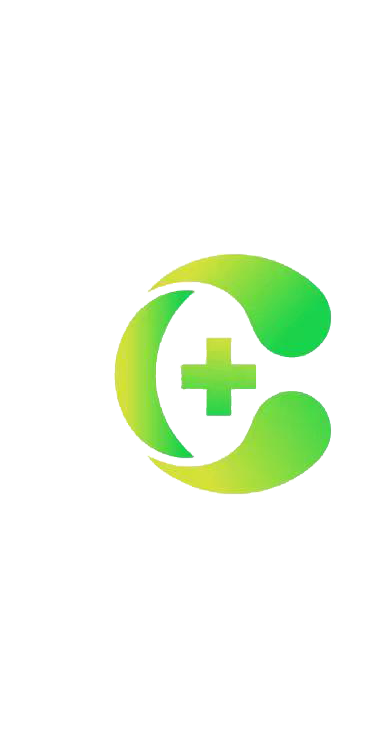Custom Spunlace Needle Punched Non Woven Fabric Steps
If you want custom spunlace non woven fabric and needle punched non woven fabric ,you can look this article for reference. written by manufacturer.
Custom spunlace non woven and needle punched non woven's Grammage Square Meter
spunlace non woven fabric: 25 ~ 110gsm
needle punched non woven fabric: 25 ~ 800gsm
Surface craft pattern display



We offer a wide variety of non-woven patterns to choose from, and more patterns can be viewed on our pinterest photo channel!
Custom spunlace non woven fabric and needle punched non woven's Fabric Material

Raw material: RPET, RPP and other recycled fibers.
Process: Non woven fabrics made through needle punching, hydroentanglement and other physical processing.
Performance: Recycling of materials, substantial reduction of carbon emissions

Raw material: viscose, cotton, hemp, acetic acid, lyocell, modal and other plant-based fibers
Process: Non woven fabric made through physical processing such as needle punching and hydroentanglement.
Performance: can be decomposed in a certain environment, reducing waste.

Raw material: mugwort, PLA, far-infrared, microcapsules and other special functional fibers.
Process: Non woven fabric made by needle punching, hydroentanglement and other physical processing.
Performance: biodegradable and at the same time gives the effect of odor purification, anti-bacteria, health and wellness, etc.
Current nonwoven layer product
01 Introduction to SerenePlush Comfort Layer
The ingredients come from nature, so you can use it with peace of mind!
Naturally self-inhibiting, with 0 additives for greater peace of mind!
Wear-resistant without linting or sizing for greater peace of mind!

SerenePlush Comfort Layer is a sanitary material surface layer is made of high-purity wood pulp, new AC fiber and differentiated fibers, with skin-friendly, comfortable, soft, infusion and excellent simulation of the silk effect, and the source of raw materials is green and biodegradable, and can be ultrasonic composite, in line with the current sanitary material industry to the green transformation of the new positioning.
SerenePlush Comfort Layer has a pH value of 5.0-5.6, which is weakly acidic, causing no irritation and zero sensitization to the skin while being naturally anti-bacterial;
With wool-like toughness and comparable to silk, SerenePlush Comfort Layer is the closest material to silk, which is certainly very soft, and its unique fiber cross-section gives the base fabric good water-absorbing and channeling properties.
Introduction to Acetate
Wood pulp sourced from sustainably managed forests
Raw materials from sustainably managed pine, oak and eucalyptus forests and woodlots (suppliers with FSC and/or PEFC chain of custody certification)
Safe and environmentally friendly use of chemicals
Safe, closed-loop process where chemicals are safe to use and solvents and water used are recycled in a reclaimed system.
Manufacturing processes with low environmental impact
With only a small carbon and water footprint in the manufacturing process from forest to fiber, AC Fiber Life Cycle Assessment results are ISO 14044 compliant and included in the Higg Material Sustainability Index.
Return to nature
Acetate has been certified ‘OK biodegradable’ and ‘OK compostable’ by TUV AYSTRIA and is finally back to nature!
Symbolism of SerenePlush
SerenePlush Comfort Layeris made of food-grade material, which is safer and more reliable; at the same time, our company adds microfiber to increase the softness of the base cloth, which is more comfortable to use, and can be used as a sanitary napkin top layer for sensitive and delicate muscles without worrying about the use of it. SerenePlush Comfort Layerhas the toughness of wool and can be comparable to silk.
SerenePlush Comfort Layer has the toughness of wool, and can be comparable to silk, is the closest to the silk material, soft and shiny.

Infusion & Ventilation
Acetate’s special shaped fiber cross-section and the grooves on the fiber surface bring about an excellent core-absorption effect, which gives the fabric good infusion properties, accelerates moisture conduction and evaporation, and keeps the surface dry.
The blade shape of the fiber has a regular and uniform structure, which makes the fiber appearance smooth and provides a long-lasting soft luster; at the same time, the grooves on the surface of the fiber increase the inter-fiber void ratio, with the unique mesh pattern, in contact with the human body, breathable, not stuffy skin.

Dry & Comfortable
Acetate moisture return rate of 6.5%, excellent moisture return rate, can make the fabric absorb water at the same time, but also can quickly discharge the excess moisture, to achieve dry and non-sticky naked feeling experience!

Skin- friendly & soft
The larger the modulus of elasticity of the fiber, the stiffer the fabric is formed, the modulus of elasticity of acetic acid fiber is small, the fabric is light and soft; soft at the same time, through the joining of differentiated fibers, abandon sizing and other chemical reagents to add, to achieve wear-resistant and lint-free characteristics!
The weak acidity of the fibers makes the fabrics have good skin-friendliness (the PH value of healthy skin is between 5.0-5.6), not easy to be allergic to, and realize the naked feeling experience when using!


"0 additions" Self-contained anti-bacyerial function
Acetate’s weak acidity makes it has a natural antibacterial adility, through the Guangzhou inspection tripartite testing center test, the antibacterial rate of Staphylococcus aureus uo to 93%, the antibacterial rate of Escherichia coli up to 98%, Candida albicans inhibit 87%, antibacterial and at the same time in line with the sanitary standards of sanitary materials pure zero-additive.

Green Biodegradable
Raw materials from wood pulp, purity of more than 95%, from nature, AC fiber has passed the ‘OK biodegradable’ and ‘OK compostable’ certificates granted by TUV AYSTRIA, and ultimately return to nature.
Ultrasonic welding possible
Acetate fiber melting point 220-250 ℃, degradable at the same time, but also ultrasonic welding.
Most of the commonly used weldable fibers are derived from petroleum, such as PP, PET, etc. are neither biodegradable nor environmentally friendly enough; while the natural fiber cotton, plant fiber viscose, Lycra, etc. are biodegradable but have no melting point can not be welded;
Acetate is one of the very few biodegradable fibers that have a melting point, which does not affect the use of fully automatic welding equipment.

02 Introduction to Lactic acid top layer


The first generation raw material of PLA is corn, which can be traced back to: corn → starch → sugar → lactic acid → PLA. It has good biodegradability, it can be decomposed by microorganisms in nature and eventually become water and carbon dioxide, it does not affect the growth of plants and does not pollute the environment, it is a recognized environmentally friendly material.
China is a major producer and consumer of chemical fibers, and in recent years has taken a leading role in the research of modified polylactic acid (PLA) fibers. Polylactic acid fiber can be blended with the traditional natural “cotton, hemp, wool and silk” made of complementary performance of woven and knitted fabrics, can also be blended with other chemical fibers such as spandex, PET, etc. made of fabrics, embodied in skin-friendly, breathable, moisture-conducting efficacy, has been popularized in the underwear fabrics and other aspects.
PLA fiber is a completely biodegradable synthetic fiber, which can be obtained from plants. Its products can be decomposed into carbon dioxide and water by microorganisms in soil, seawater and wastewater after being discarded, and when burned, it will not emit poisonous gas or cause pollution. It is a kind of sustainable ecological fiber.
Polylactic acid fiber (PLA) production raw material lactic acid is made from corn starch, so this fiber is also known as corn fiber, with PLA as raw material to get the products, has good biocompatibility and bioabsorbability, as well as bacteriostatic, flame retardant, and in the biodegradable thermoplastic polymer materials, polylactic acid has the best heat resistance.
Lorem ipsum dolor sit amet, consectetur adipiscing elit. Ut elit tellus, luctus nec ullamcorper mattis, pulvinar dapibus leo.
Methyl Lactate:
Methyl Lactate is a liquid with a boiling point of 145°C. It is miscible with water and most organic liquids and can be used as a solvent for paint colorants and cellulose materials. In addition, it can be used in the production of crispy pastry.
Ethyl lactate:
ethyl lactate is a colorless transparent liquid, slightly odor, relative density 1.030-1.042, boiling point 140-160 ° C, freezing point -25 ° C, refractive index of 1.4125, can be mixed with water and partially decomposed, soluble in alcohols, ethers, ketones, esters and other solvents. Also soluble in carbon cyanide compounds and oils, can be used as a solvent for cellulose nitrate and cellulose acetate, it is also one of the commonly used food spices, and used in milk, cream and fruit wines, etc. In addition, it can be used as a lubricant in the pharmaceutical industry pressed tablets, drugs, cardiac static synthesis of intermediates. In the rubber processing industry is mainly used in the production of neoprene rubber latex diffusion impregnated products, can improve the wetting properties of the mold, so that the film is uniform and consistent, and can be used as a latex wetting agent, can improve the water in the latex on the wetting capacity of the powder additives or to increase the latex on the penetration of the textile reinforcing materials and diffusion capacity.
By utilizing the lactic acid production technology of the Cakir Company and the polymer production technology of the Dau Company, and by researching and developing new products and new applications, the company predicts that the production of polylactic acid (PLA) will be developed into a scale of 455,000 tons per year in the next ten years.
5.2 Synthesis of polylactic acid
At present, the synthesis of PLA mainly adopts the polycondensation method with lactic acid as raw material. Also part of the use of propylene glycol ester ring-opening polymerization method and carbon monoxide and acetaldehyde copolymerization method. Carbon monoxide and formaldehyde copolymerization method is being developed. In addition, lactic acid can also be copolymerized with lactone to produce high-strength rubber elastomers. Polylactic acid can be modified by reacting it with other polymers, or by reacting it with phenol or ethanol.
5.3 Properties of PLA
Lactic acid is known to be optically active, and there are three types of polymers: poly(L-lactic acid) (PLLA), poly(dextro-lactic acid) (PDLA), and poly(levo-levo-levo-levo-levo-levo-levo-levo-levo-levo-levo-levo-levo-levo-levo-levo-levanoic acid).
PLA is made from starch raw materials derived from renewable plant resources (e.g. corn, cassava, etc.). The starch material is saccharified to obtain glucose, and then the glucose and certain strains of bacteria are fermented to make high-purity lactic acid, and then a certain molecular weight of PLA is synthesized by chemical synthesis. Polylactic acid is synthesized by using lactic acid as raw material, so our surface fabric is called: lactic acid surface fabric.
Properties of polylactic acid
Use of bio-based raw materials, green environmental protection
Anti-bacterial, anti-mite, anti-allergy
Skin-friendly, breathable and strong
Good biocompatibility, biodegradable
Ultrasonically weldable, highly moldable
Bacteriostatic report
Certificate of Degradability




